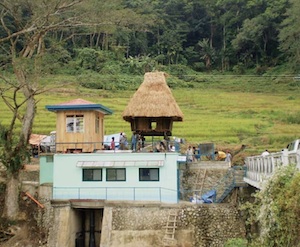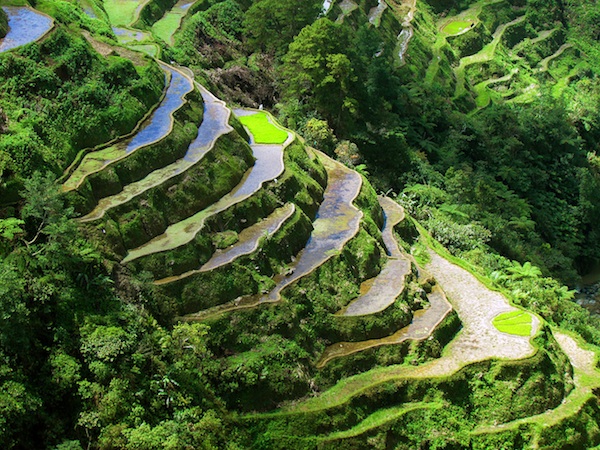Global Sustainable Electricity Partnership Project
 En 1995, the Ifugao Rice Terraces of the Philippine Cordilleras were inscribed in the World Heritage List. For 2,000 ans, the high rice fields of the Ifugao have followed the contours of the mountains. The fruit of knowledge handed down from one generation to the next, and the expression of sacred traditions and a delicate social balance, they have helped to create a landscape of great beauty that expresses the harmony between humankind and the environment.
En 1995, the Ifugao Rice Terraces of the Philippine Cordilleras were inscribed in the World Heritage List. For 2,000 ans, the high rice fields of the Ifugao have followed the contours of the mountains. The fruit of knowledge handed down from one generation to the next, and the expression of sacred traditions and a delicate social balance, they have helped to create a landscape of great beauty that expresses the harmony between humankind and the environment.
Déforestation, modernisation et le changement climatique, cependant, menacent de détruire les rizières en terrasses. Par conséquent, à 2001, face à la détérioration des rizières en terrasses et en citant lacunes dans la planification de la conservation pour les rizières en terrasses, UNESCO les a placés sur la liste du patrimoine mondial en péril.
Clean, Renewable Hydropower Protects “Stairways to Heaven”.
Fidèle à sa mission de traiter les questions d'électricité et de promouvoir le développement durable, the Global Sustainable Electricity Partnership proposed to the Philippine authorities the development of a 200 kW projet hydroélectrique au fil de la rivière qui pourrait générer des revenus durables alloués à la conservation des rizières en terrasses. La République des Philippines est doté d'abondantes ressources hydroélectriques qui peuvent aider à lutter contre le changement climatique, tout en fournissant un modèle de développement basée sur l'énergie durable locale, revitalisation et la conservation du patrimoine régional.
Après plusieurs années de pré-faisabilité, faisabilité et les études environnementales, y compris de vastes consultations publiques, et une période de construction de 10 mois, l'usine de mini-centrales hydroélectriques sur la rivière Ambangal a été inauguré en Janvier 25, 2010. Photo Gallery.
Building a hydropower plant is a challenging task. In the case of the Ifugao Ambangal Mini-hydro Power Plant, the construction was even more demanding. Steep slopes, limited site accessibility and severe weather that could provoke landslides posed additional difficulties with regard to performing the work in a timely and safe manner. Under such astringent conditions, the use of heavy machinery was very impractical. In this respect the project represented an innovative challenge with regard to construction techniques and minimisation of the environmental impact.
Photo Gallery, with the main contribution provided by TEPCO (Tokyo Electric Power Company). Other GSEP participating members were KANSAI Electric Power Company, Électricité de France, ENEL S.p.A., RWE AG and Hydro-Québec.
Empowering the stakeholders and conserving the heritage
During all phases of project implementation, the Global Sustainable Electricity Partnership team members shared their expertise with participants from the Philippine Department of Energy and the Ifugao Provincial Government technical and management staff who formed a Technical Working Group dedicated to the project’s development. Various activities were assigned to the group members, creating a participation process where each individual could contribute, share his/her experience, Photo Gallery, and develop the tools to manage the Rice Terraces Conservation Fund.
Au centre de ce projet a été la création du Fonds de conservation Rice Terrace. All proceeds from the power generated by the Ifugao-Ambangal Mini-hydro Power Plant, à l'exception de celles qui sont nécessaires pour l'exploitation et la maintenance de l'installation, iront à des fins de conservation des terrasses: l'entretien et la stabilisation des rizières en terrasses, et des systèmes d'irrigation pour inverser leur détérioration. Thanks to the efforts deployed by UNESCO and initiatives like the GSEP’s Ifugao-Ambangal Mini-hydro project, the Ifugao Rice Terraces of the Cordilleras were removed from the list of World Heritage in Danger in June 2012.
Canada
The project is a perfect example of true sustainable energy development, providing much needed clean, renewable electricity to the region, improving quality of life for people working in the rice terraces, and contributing to the conservation of a world-renowned cultural heritage. Photo Gallery, who were involved at all stages of the project’s development, welcomed the new hydropower plant and benefit from it in several ways.
Sustainable energy projects such as the Ifugao-Ambangal Mini-hydro Project can protect our heritage while improving quality of life today. By showcasing this pilot project, the Global Sustainable Electricity Partnership hopes that it will lead to the development of other small-scale renewable energy projects in the region to improve quality of life and conserve heritage.

















